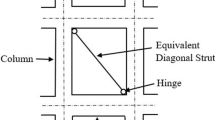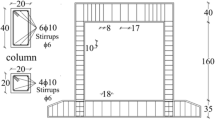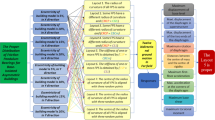Abstract
Structures in earthquake-prone areas are not subjected to a single seismic event, but also to a seismic sequence consisting of mainshock and several aftershocks. However, the influence of seismic sequence on performance of structures has not been addressed in majority of existing seismic codes. This paper investigates the effect of repeated earthquakes on performance of steel buckling restrained braced frames. For this purpose, 4-story and 10-story prototype buckling restrained braced frames, designed according to Iranian building codes, are exposed to five seismic sequences. Nonlinear time history analyses are conducted and the responses of frames are measured in terms of maximum inter-story and residual drifts. Furthermore, Park–Ang damage indices and global ductility factors are obtained for braced frames under examined mainshocks and mainshock–aftershock sequences. From the results of this research, it is found that the seismic sequence has the potential to increase the inter-story drift, residual drift, damage index and global ductility factor of buckling restrained braced frames. It is also highlighted that the spectral acceleration of mainshock–aftershock sequence, in comparison to that of single event mainshock, considerably affects the performance of buckling restrained braced frame under repeated earthquakes.












Similar content being viewed by others
References
Abdollahzadeh G, Sadeghi A (2018) Earthquake recurrence effect on the response reduction factor of steel moment frame. Asian J Civ Eng. https://doi.org/10.1007/s42107-018-0079-3
Aki K (1984) Asperities, barriers, characteristic earthquakes and strong motion prediction. J Geophys Res 89:5867–5872
Amadio C, Fragiacomo M, Rajgelj S (2003) The effects of repeated earthquake ground motions on the non-linear response of SDOF systems. Earthq Eng Struct Dynam 32:291–308
Avci-Karatas C, Celik O, Yalcin C (2018) Experimental investigation of aluminum alloy and steel core buckling restrained braces (BRBs). Int J Steel Struct Springer 18(2):650–673. https://doi.org/10.1007/s13296-018-0025-y
Avci-Karatas C, Celik OC, Eruslu SO (2019) Modeling of buckling restrained braces (BRBs) using full-scale experimental data. KSCE J Civ Eng Springer 23(10):4431–4444. https://doi.org/10.1007/s12205-019-2430-y
Black CJ, Makris N and Aiken ID (2000) Component testing, stability analysis and characterization of buckling restrained braced frames. PEER Report No 8, Berkeley, CA.
Celik OC, Yuksel E, Avci-Karatas C, Bal A, Gokce T, Bago Z, Koller G (2015) Component testing of steel-core buckling restrained braces (BRBs) with pinned end connections. The 8th International conference on advances in steel structures (ICASS-2015), July 21–24, Lisbon, Portugal.
Chopra A (2006) Dynamics of structures: theory and applications to earthquake engineering, 3rd edn. Prentice Hall Inc, New Jersey
Dalguer L. A., Miyake H and Irikura K (2002) Characterization of dynamic asperity source models for simulating strong ground motion. Proc. 13th World conference on earthquake engineering, Paper No. 3286, Vancouver, Canada
Diaz-Martinez G, Ruiz-Garcia J, Teran-Gilmore A (2014) Response of structures to seismic sequences corresponding to Mexican soft soils. Earthq Struct 7:1241–1258
Etabs (2016) Integrated software package for the structural analysis and design of buildings, Computers and structures, Inc. (CSI).California
Fahnestock L, Ricles J, Sause R (2007) Experimental evaluation of a large-scale buckling-restrained braced frame. J Struct Eng 133:1205–1214
FEMA-356 (2000) Pre-standard and commentary for the seismic rehabilitation of buildings, ASCE, Federal emergency management agency, Washington D.C.
Fragiacomo M, Amadio C, Macorini L (2004) Seismic response of steel frames under repeated earthquake ground motions. Eng Struct 26:2021–2035
Guerrero H, Ruíz-García J, Alberto Escobar J, Terán-Gilmore A (2017) Response to seismic sequences of short-period structures equipped with buckling-restrained braces located on the lakebed zone of Mexico City. J Constr Steel Res 137:37–51
Guo Y, Tong J, Zhang B, Zhu B, Pi Y (2017) Theoretical and experimental investigation of core-separated buckling-restrained braces. J Constr Steel Res. 135:137–149
Hatzigeorgiou GD, Beskos DE (2009) Inelastic displacement ratios for SDOF structures subjected to repeated earthquakes. Eng Struct 31:2744–2755
Hatzigeorgiou GD (2010) Ductility demand spectra for multiple near- and far-fault earthquakes. Soil Dyn Earthq Eng 30:170–183
Hatzigeorgiou GD, Liolios AA (2010) Nonlinear behavior of RC frames under repeated strong ground motions. Soil Dyn Earthq Eng 30:1010–1025
Hoveidae N, Rafezy B (2012) Overall buckling behavior of all-steel buckling restrained braces. J Constr Steel Res. 79:51–158
Hoveidae N, Habibi Pourzare B (2019) Comparison of progressive collapse capacity of steel moment resisting frames and dual systems with buckling restrained braces. J Rehabil Civ Eng 7(4):37–56
Iranian code of practice for seismic resistant design of buildings (2014) Standard No. 2800, 4th Edition Building and housing research center, Tehran, Iran.
Kanvinde A, Deierlein G (2007) Cyclic void growth model to assess ductile fracture initiation in structural steels due to ultra-low cycle fatigue. J Struct Eng 133(6):701–712
Kaveh A, Kalateh-Ahani M, Fahimi-Farzam M (2014) Damage-based optimization of large-scale steel structures. Earthq Struct 6:1119–1139
Lee K, Foutch DA (2004) Performance evaluation of damaged steel frame buildings subjected to seismic loads. J Struct Eng 130:588–599
Li Q, Ellingwood BR (2007) Performance evaluation and damage assessment of steel frame buildings under main shock-aftershock sequences. Earthq Eng Struct Dyn 36:405–427
Liolios A, Hatzigeorgiou G (2013) A numerical approach for estimating the effects of under multiple earthquakes to seismic response of structures strengthened by cable-elements. J Theor Appl Mech 43(3):21–32
Liolios A, Elenas A, Liolios A, Radev S, Georgiev K, Georgiev I (2015) Tall RC Buildings environmentally degradated and strengthened by cables under multiple earthquakes: A numerical approach. In: Dimov I, Fidanova S, Lirkov I (eds) Numerical methods and applications. NMA 2014. Lecture notes in computer science, vol 8962. Springer, Cham
Loulelis D, Hatzigeorgiou GD, Beskos DE (2012) Moment resisting steel frames under repeated earthquakes. Earthq Struct 3:231–248
Luco N, Bazzurro P and Cornell CA (2004) Dynamic versus static computation of the residual capacity of mainshock-damaged building to withstand an aftershock. Proc 13th World conference on earthquake engineering, Paper No. 2405, Vancouver, Canada
Mahin SA (1980) Effects of duration and aftershocks on inelastic design earthquakes. Proc of the seventh world conference on earthquake engineering, Istanbul 5: 677–679
Ma N, Wu B, Zhao J, Li H, Yang W (2008) Full-scale test of all-steel buckling restrained braces. 14th world conference on earthquake engineering, Beijing, China
Massumi A, Absalan M (2013) Interaction between bracing system and moment resisting frame in braced RC frames. Archives Civ Mech Eng 13:260–268
Merrit S, Uang C, Benzoni G (2003) Subassemblage testing of corebrace buckling-restrained braces, Final Report to Core Brace, LLC. Report No. TR-2003/0
Morfuni F, Freddi F, Galasso C (2019) Seismic performance of dual systems with BRBs under mainshock-aftershock sequences. 13th International conference on applications of statistics and probability in civil engineering, ICASP13 Seoul, South Korea
OpenSEES (2014) Open system for earthquake engineering simulation. Pacific earthquake engineering research center, University of California, Berkeley, California
Park YJ, Ang AHS (1985) Mechanistic seismic damage model for reinforced concrete. J Struct Eng ASCE 111(4):722–739
Prinz GS, Richards PW (2012) Seismic performance of buckling-restrained braced frames with eccentric configurations. J Struct Eng 138(3):345–353
Ruff F, Kanamori H (2003) The rupture process and asperity distribution of three great earthquakes from long-period diffracted P-waves. Phys Earth Planet Inter 31:202–230
Ruiz-García J, Negrete-Manriquez JC (2011) Evaluation of drift demands in existing steel frames under as-recorded far-field and near-fault mainshock–aftershock seismic sequences. Eng Struct 33:621–634
Ruiz-García J (2012) Mainshock-aftershock ground motion features and their influence in building’s seismic response. J Earthq Eng 16:719–737
Ruiz-García J, Yaghmaei-Sabegh S, Bojórquez E (2018) Three-dimensional response of steel moment-resisting buildings under seismic sequences. Eng Struct 175:399–414
Sabelli R, Mahin S, Chang C (2003) Seismic demands on steel braced frame buildings with buckling restrained braces. Eng Struct 5:655–666
Tremblay R, Bolduc P, Neville R, Devall R (2006) Seismic testing and performance of buckling-restrained bracing systems. Can J Civ Eng 33:183–198
Vasilopoulos AA, Beskos DE (2006) Seismic design of plane steel frames using advanced methods of analysis. Soil Dyn Earthq Eng 26(12):1077–1100
Zona A, Dall’Asta A (2012) Elastoplastic model for steel buckling-restrained braces. J Constr Steel Res 68:118–125
Author information
Authors and Affiliations
Corresponding author
Additional information
Publisher's Note
Springer Nature remains neutral with regard to jurisdictional claims in published maps and institutional affiliations.
Rights and permissions
About this article
Cite this article
Hoveidae, N., Radpour, S. Performance evaluation of buckling-restrained braced frames under repeated earthquakes. Bull Earthquake Eng 19, 241–262 (2021). https://doi.org/10.1007/s10518-020-00983-0
Received:
Accepted:
Published:
Issue Date:
DOI: https://doi.org/10.1007/s10518-020-00983-0




